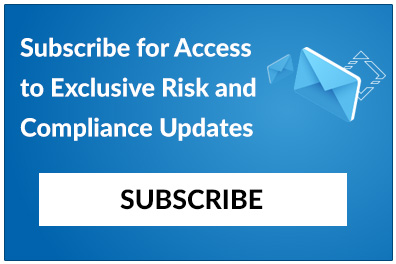Home/ Blog / Aligning a CMS with Your Institution’s 2026 Risk Profile
Taking the time to develop a well-aligned compliance management system (CMS) is not a nice-to-have. This system needs to be applied across operational spheres for banks, insurers, non-bank lenders, and credit unions to mitigate risks.
Compliance is no longer a reactive space and now requires organizations to be proactive in their strategies for risk integration. Anticipating emerging GRC trends is key to staying ahead of changes in data governance, third-party oversight and other enforcement measures.
Scaling According to Risk Profile
The challenge facing many financial organizations when it comes to implementing an effective framework for compliance is correctly mapping their risk profile. This unique overview will determine controls, oversight, and technology that need to be adapted.
We recommend using these guidelines to approach scaling your compliance management. Consider the:
- Size and structure of your organization
- Complexity of your organization’s operations
- Organization’s regulatory jurisdiction
For example, while smaller organizations may be able to house their compliance framework under a single governing framework, larger entities may need to spread enterprise-wide compliance standards across business units for localized ownership.

Consequences of a Misaligned CMS
An integrated CMS cannot be applied without alteration across the board. The system must be developed according to the organization’s actual risk profile. Such a misalignment could result in over-policing of low-risk activities, while high-risk activities may not receive the proper oversight.
Apart from the potentially wasted resources, organizations may also experience:
- Regulatory gaps during examinations
- Potential fines for non-compliance
- A lack of stakeholder confidence
- A higher staff turnover
Not only can these consequences be avoided, but the 2026 regulatory environment will also be more rewarding for organizations that take the time to invest in how their CMS aligns with their risk profile.
Leveraging Predictive AI Technology
Advanced compliance technologies allow organizations to simplify compliance management.
Integrating advanced technology into your organization’s compliance management approach is key to remaining aligned with upcoming risk priorities. GRC platforms like Predict360 simplify compliance management through automation and predictive analytics that take your organization’s risk profile into account.
Read more on our blog to understand the benefits of and steps towards achieving integrated risk management for your organization or see our overview here:
| Benefit | Description |
|---|---|
| Centralized Data Hub | Consolidates policies, controls, risks, and regulatory requirements in one accessible platform. |
| Regulatory Updates | Keeps compliance content current automatically. |
| Predictive Analytics | Uses AI to anticipate compliance risks before they materialize, enabling proactive rather than reactive compliance. |
| Jurisdictional Visibility | Provides unified dashboards showing compliance status. |
| Workflow Automation | Streamlines routine compliance tasks. |
| Scalability | Adapts to organizational growth and changing complexity. |
| Real-Time Dashboards | Enables instant visibility into compliance status, control effectiveness, and emerging gaps. |
| Audit Trail | Maintains comprehensive records of compliance activities. |
| Integrated Risk Assessment | Links compliance obligations directly to business risks. |
| Reduced Manual Effort | Decreases reliance on spreadsheets and disconnected tools. |
CMS Scalability and Risk Profile Alignment
Our experts have compiled a list of commonly asked questions and answers to help your organization best align your CMS with your risk profile.
Why does CMS alignment matter in 2026?
Regulatory bodies are becoming stricter and regulatory changes more complex. A CMS that is well-aligned with your risk profile means compliance controls will be proportionate to the actual risk, so resources are deployed efficiently. This, in turn, will reduce the exposure to risk, fewer control gaps, and optimal use of resources.
How should institutions approach CMS scaling?
Scaling depends on three primary factors:
- Organizational size
- Operational complexity
- Regulatory jurisdiction
The key is to ensure that compliance intensity matches risk exposure.
How does institutional size impact CMS design?
The larger the organization, the more sophisticated the technology needs to be, and the more complex GRC structures will be for different business units.
Smaller organizations, on the other hand, may be able to operate in a more streamlined manner. However, size is not the only factor that will impact CMS design, which is why it is vital to consider each organization’s unique risk profile.
What role does operational complexity play in CMS alignment?
Operational complexity for organizations can stem from aspects such as:
- Diverse product offerings
- Third-party relationships
- Multiple markets
These and other factors will affect the number of applicable regulations and controls. Therefore, a CMS needs to address these overlapping gaps while integrating advanced technology that can accommodate more complexity.
How do cross-border operations affect CMS structure?
Operating across multiple jurisdictions means navigating varying:
- Regulatory frameworks
- Governance requirements
- Reporting standards
However, when an organization operates with a unified CMS, processes remain consistent globally while allowing variations in policies and controls based on specific jurisdictions.
Ultimately, responding to regulatory changes and other complexities in risk management in 2026 will require flexibility and adaptability. Implementing an effective CMS will give your organization an edge, allowing for forward-looking thinking and planning across all business units.
Request a Demo
Complete the form below and our business team will be in touch to schedule a product demo.
By clicking ‘SUBMIT’ you agree to our Privacy Policy.


